Summary of national blue-green algae monitoring in June-August 2025: Unexceptional blue-green algae situation in many places despite hot weather
Cool and unstable weather conditions in early summer kept blue-green algae blooms at bay, and the number of observations was below the long-term average. A heat wave in July boosted the occurrence of blue-green algae and raised observation numbers to a relatively normal level for the period in many places. While regional variations occurred in all water areas, as a whole the blue-green algae situation was close to the usual long-term average in many places. During the past summer, citizens took part in observations with unprecedented diligence.
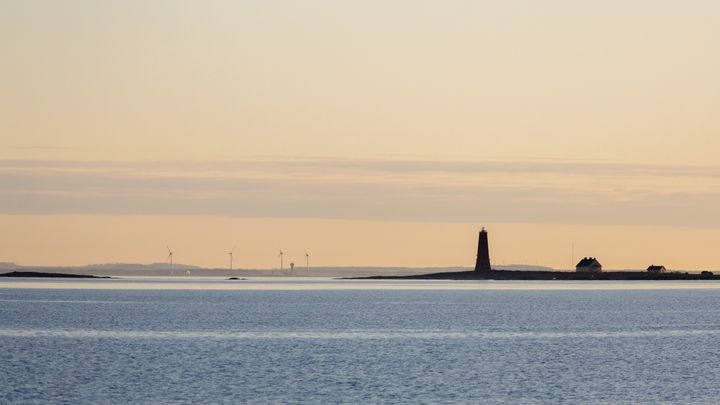
Observations in inland waters, coastal areas and open sea areas in summer 2025
Thanks to the cool and unstable weather in June, relatively small amounts of blue-green algae were observed in inland waters across the country. In early summer, slightly lower volumes of blue-green algae were observed compared to the long-term average (1998–2024). In late June and early July, the number of observations went up and returned to the typical level for the time period.
The hot and calm period that started in mid-July brought surface water temperatures up to record levels in places, promoting algae growth. The number of observations remained at a fairly typical level compared to the long-term average, however, and dropped again in late July and early August. In the early stages of the heat wave, the algae had time to consume most of the nutrients in the water. With further weeks of hot weather and no rain, no additional nutrients from the catchment were transported into water bodies. Neither did winds raise nutrients from the hypolimnion in lakes into the epilimnion, which contributed to curbing algae growth. While the rains typical of late summer carried more nutrients into water systems, blue-green algae blooms remained mostly moderate.
The unstable weather of early summer kept the growth of blue-green algae at bay in coastal waters, and algae observations only increased in mid-July this summer. In June the number of blue-green algae observations was clearly below the long-term average. The seawater temperature was also relatively low in June. In late June and early July, the number of blue-green algae observations reached the typical level for the time period but remained moderate.
The heat wave that started in July increased the seawater temperature and the number of blue-green algae observations on the coast increased, reaching the usual level for this time period. After first decreasing in August, the number of observations exceeded the long-term average in mid-August. The largest number of blue-green algae observations in coastal areas during the summer was reported for mid-August. While the largest amounts of blue-green algae were observed in the coastal areas of Uusimaa, Kymenlaakso and Southwest Finland this summer, these algae were observed all along the coast up to the Bothnian Bay.
In open sea areas the blue-green algae situation varied greatly depending on weather conditions and winds. All in all, the blue-green algae situation in the open sea was fairly normal in comparison to the entire period of the 2000s. In order for blue-green algae blooms to build up in surface waters, a warm and sunny period of a few weeks is needed, followed by at least a couple of days of calm weather. This summer, a heat wave in July encouraged blue-green algae growth, and calm weather brought the algae to the surface in mid-July. In western parts of the Gulf of Finland, the peak of blue-green algae blooms in mid-July was relatively short. The observations of blue-green algae surface blooms in open sea areas were also relatively normal in the eastern Gulf of Finland, the northern part of the Baltic Sea's main basin, the Åland Sea and the Bothnian Sea. In the Bothnian Bay and Kvarken areas, these algae were only observed locally along the coasts.
At the Utö Atmospheric and Marine Research Station, located offshore in the southern Archipelago Sea, the most common blue-green algae species in early summer were Aphanizomenon flosaquae and Dolichospermum spp. At the end of July, the biomass of Nodularia spumigena increased, and in August, N. spumigena became the dominant blue-green algae species in Utö. All three species typically occur in marine samples during the summer season, although their relative proportions vary.
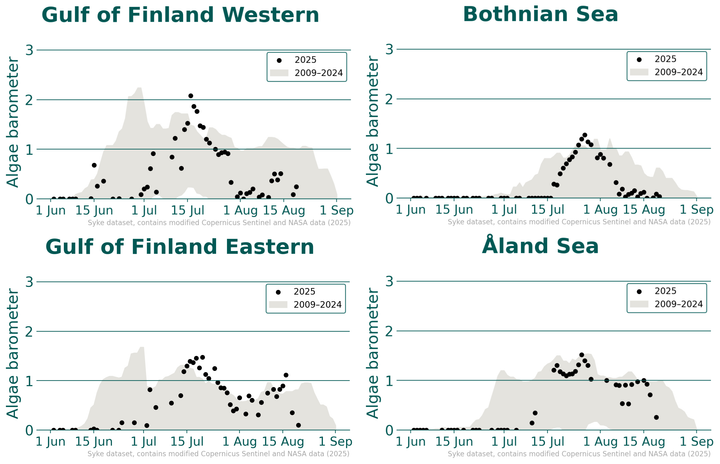
The blue-green algae situation in open sea areas can be monitored using algae barometers compiled from satellite data in the Tarkka service. The barometers are calculated daily from cloud-free observations by the Sentinel-3 satellite’s OLCI instrument and published in the Tarkka service.
Modelling-based risk assessment of blue-green algae blooms:
An assessment of the blue-green algae risk in open sea areas for summer 2025 was prepared in early June. It combined forecasts produced by a statistical and a machine learning model. As input data for the models were used data from the Finnish Environment Institute, open sea monitoring data of the Swedish Meteorological and Hydrological Institute (SMHI), coastal monitoring data of the Centres for Economic Development, Transport and the Environment (ELY Centres), the results of Alg@line monitoring carried out by commercial vessels, and satellite image and weather data.
Satellite observations indicate that large blue-green algae blooms developed in open sea areas where the models identified a high risk. No surface blooms of blue-green algae occurred in areas were the risk was estimated to be low. Consequently, the risk assessment predicted well the occurrence of blue-green algae in the open sea areas surrounding Finland. Small-scale regional variations in algae volumes in such as coastal areas cannot be anticipated.

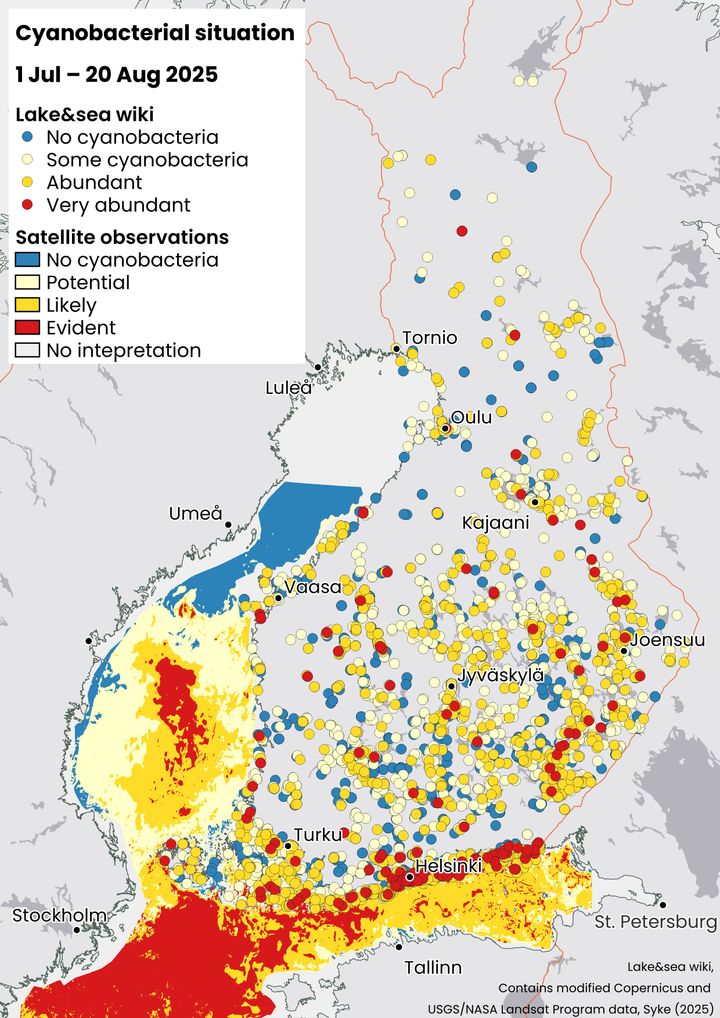
Citizens reported a record number of blue-green algae observations
This summer, the national blue-green algae monitoring in Järvi-meriwiki comprised 373 observation points, 97 of which are located in the sea and 276 in inland waters. Citizens have additionally recorded in Järvi-meriwiki their observations of the blue-green algae situation at over 800 different locations.
A total of 5,709 observations of the blue-green algae situation had been recorded in Järvi-meriwiki this year by 25 August. Official monitoring accounts for 3,919 of them, while 1,790 are citizens' observations or others not included in the official monitoring. Blue-green algae were detected in 535 (14%) of the official monitoring observations and 821 (46%) of the others.
In addition to Järvi-meriwiki, citizens could also report their algae observations in Vesi.fi. While the entries in Vesi.fi are displayed on observation maps for a few days, they are not linked to observation sites or archived. This year, 2,199 observations concerning the blue-green algae situation had been reported in Vesi.fi before the publication of this summary. Blue-green algae were found in 1,869 (85%) of them.
By 25 August 2025, a total of 3,989 citizens' observations have been reported using the two services. This considerably exceeds last year’s approx. 2,500 observations and is a new record in the history of blue-green algae monitoring.
Syke monitors the occurrence of blue-green algae as part of monitoring the state of the environment
The Finnish Environment Institute Syke monitors the occurrence of blue-green algae as part of the monitoring of the state of the environment and, between June and August, publishes a weekly overview of the blue-green algae situation in inland waters and in sea areas close to Finland. The blue-green algae monitoring continues until the end of September, and the weekly national situation report was published this year between 19 June and 7 August.
The typical time for blue-green algae blooms is from the turn of June-July until August. In late summer, cool nights usually lower the surface temperatures of the waters, which may curb the occurrence of blue-green algae blooms. As the amount of daylight decreases so does the growth of blue-green algae. However, even abundant blue-green algae blooms may still occur well into the autumn. If sufficient nutrients are available for blue-green algae, the blooming may continue even under the ice cover. The phycocyanin colour pigment released from degrading blue-green algae cells can stain water and shores, as well as ice fissures to turquoise or blueish in the winter, and form turquoise paint-like mass on the shores. Degrading blue-green algae mass may also cause an unpleasant smell.
National blue-green algae monitoring has been carried out since 1998. Syke conducts the monitoring in cooperation with the Centres for Economic Development, Transport and the Environment (ELY Centres) and municipal environmental authorities. Finland’s Rotary has also been involved in the blue-green algae monitoring for several years. Citizens can participate in the monitoring by sending their observations to the Järvi-meriwiki through the Havaintolähetti application or via the blue-green algae map service on the Waterinfo.fi website.
Information on the blue-green algae situation in Finland's nearby sea areas was obtained from satellite images, the Finnish Border Guard, the marine research vessel Aranda, measurements of blue-green algae species, biomass and pigment at Utö atmospheric and marine observation station, as well as from cruise and merchant vessels fitted with Alg@line equipment. The Finnish Meteorological Institute's marine services provided up-to-date information on the surface temperature of seawater. The drifting forecasts for blue-green algae mats were prepared weekly in cooperation between Syke and the Finnish Meteorological Institute's marine services. This year, satellite observations were utilised not only in sea areas but also in approximately 80 lake areas.
Syke wants to thank all parties involved in blue-green algae observations for their important cooperation also this year!
National algae reporting
Satellite observations can be found in Syke's Tarkka service
Utö atmospheric and marine observation station and Alg@line monitoring
-
Utö species, blue-green algae biomass, and pigment results
Keywords
Contacts
Communications:
Vilma Rikala, firstname.lastname@syke.fi, Tel. +358 295 251 085
Inquiries about blue-green algae situation
Telephone 12 pm to 3 pm
Lakes: Tel +358 50 5734 347 or +358 295 251 326
Ecology of blue-green algae in the Baltic Sea: Tel +358 50 5693 297 or +358 295 251 314
Satellite observations: Tel 358 50 4707 576 or +358 295 251 329, e-mail: Eotuki@syke.fi
Media service at Finnish Environment Institute
Our Media Service provides information on research, helps journalists find experts for interviews and provides photos for media use.
Our Communication experts will answer your inquiries on weekdays from 9 am to 4 pm.
Images
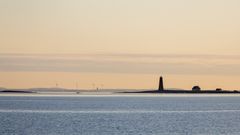
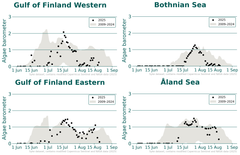

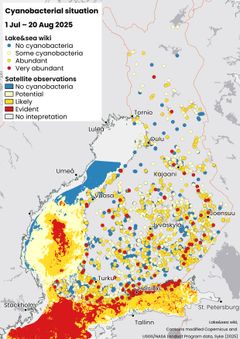
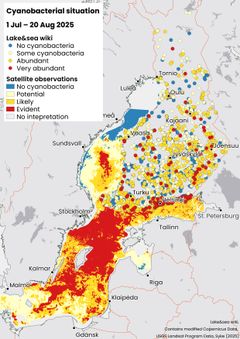
Links
Finnish Environment Institute - We build hope through research.
Finnish Environment Institute
Latokartanonkaari 11
00790 Helsinki
+358 295 251 000
It is time to move beyond solving environmental problems one by one, to systemic sustainability transformations. The Finnish Environment Institute (Syke) contributes to building a sustainable society through research, information and services. The Finnish Environment Institute is a research institute with 700 experts and researchers located in Helsinki, Oulu, Jyväskylä and Joensuu.

Subscribe to releases from Suomen ympäristökeskus
Subscribe to all the latest releases from Suomen ympäristökeskus by registering your e-mail address below. You can unsubscribe at any time.
Latest releases from Suomen ympäristökeskus
Viikkokatsaus 1.–5.9.202528.8.2025 11:48:49 EEST | Tiedote
Hei! Tässä tiedoksesi meillä Suomen ympäristökeskuksessa ensi viikolla ilmestyviä tiedotteita, uutisia, kampanjoita, blogeja ja uutiskirjeitä. Mukana myös tulevia tapahtumia ja webinaareja. Jakelemme viikkokatsauksen torstaisin STT:n kautta. Koosteet löytyvät myös STT-uutishuoneesta, josta voit tilata kaikki Suomen ympäristökeskuksen tiedotteet.
Long-term monitoring indicates clear changes in Baltic Sea ecosystem28.8.2025 10:30:00 EEST | Press release
Oxygen situation in the depths of Finland's southern sea areas has deteriorated. While nutrient loading has been curbed, phosphate phosphorus concentrations have increased over the long term. These changes have also shaped the benthos and zooplankton communities.
Långtidsövervakning pekar på tydliga förändringar i Östersjöns ekosystem28.8.2025 10:30:00 EEST | Pressmeddelande
Syreläget på de djupa bottnarna har försämrats i de södra delarna av Finlands havsområde. Trots att näringsbelastningen har minskat, har halterna av fosfatfosfor ökat på lång sikt. Också djurplankton- och bottendjursamhällena har påverkats av förändringarna.
Pitkäaikaisseurannat kertovat selvistä muutoksista Itämeren ekosysteemissä28.8.2025 10:30:00 EEST | Tiedote
Syvien pohjien happitilanne on heikentynyt Suomen eteläisillä merialueilla. Fosfaattifosforin pitoisuudet ovat pitkällä aikavälillä kasvaneet, vaikka ravinnekuormitusta on hillitty. Muutokset ovat muokanneet myös eläinplankton- ja pohjaeläinyhteisöjä.
Sammandrag av den riksomfattande uppföljningen av cyanobakterier juni–augusti 2025: Trots värmen var mängden cyanobakterier på många håll normal28.8.2025 10:30:00 EEST | Pressmeddelande
Det svala och ostadiga vädret på försommaren dämpade cyanobakterieblomningarna och färre observationer gjordes jämfört med långtidsmedelvärdet. Värmeböljan i juli ökade förekomsten av cyanobakterier, vilket ledde till att observationerna på många håll ökade till en rätt normal nivå för tidpunkten. Det förekom regional variation i alla vattenområden, men som helhet var cyanobakterieläget på många håll normalt jämfört med långtidsmedelvärdet. Under den gångna sommaren deltog medborgarna i observationerna med en enastående flit.
In our pressroom you can read all our latest releases, find our press contacts, images, documents and other relevant information about us.
Visit our pressroom